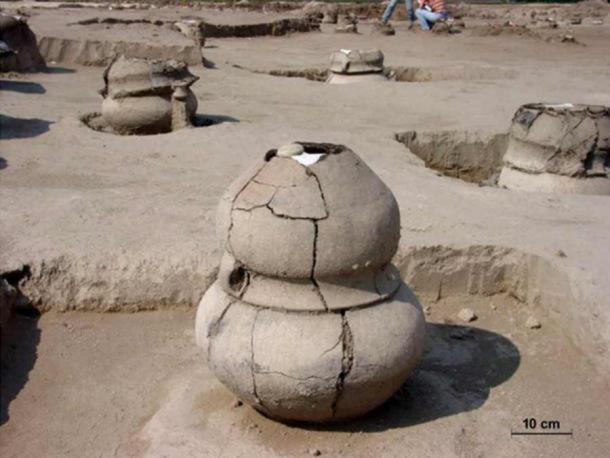In the Inner Mongolia Autonomous Region, in northern China, archaeologists have unearthed tombs with urn burials – of 128 children! The remains of these 128 children have been found near the ruins of an ancient city in Liangcheng County, Ulanqab, which date to the Han Dynasty (202 BC – 220 AD), as per a statement by the regional cultural relics and archaeology research institute, reports Chinese news agency, Xinhua. This is the first time so many tiled coffins have been found in the county.
Urn Burials – A Need of the Hour
The excavation team unearthed the tombs along with coins, pottery, and tiles that were part of an ancient funerary practice. During this period of the Han Dynasty, the bodies of children were not cremated, and the continued practice of burial with grave goods was still in use since the Neolithic period (from 5,000 BC onwards). Interestingly this would continue till the end of the Ming dynasty, 1644 AD. With children, multiple urns were connected to create some kind of a protective layer, or ‘home’ for the body.
“We do not really know why, but it seems that, in this region, people started to use urn burials to bury their passed away children. In ancient China, cremation appeared quite late, usually after the Han period. In some places, we do find cremated burials dating to the Bronze Age, but in the central plains, they usually appear quite late,” said Lam Wen-cheong, an assistant professor at the Chinese University of Hong Kong.

One of the 128 child urn burials discovered in Liangcheng County. ( Institute of Cultural Relics and Archaeology of Inner Mongolia Autonomous Region/Xinhua News )
The tombs were elaborate and grandiose, reports South China Morning Post. They were brick chambers filled with objects for ‘the afterlife’. The wealthy decorated their funeral spaces with elaborate artworks that showed grand processions of hundreds of people and chariots who showed up to pay respect for the deceased. Some tombs were so grand that they are referred to as ‘palace tombs,’ in reference to the elite adopting them.
For regular people, this end-of-life ritual was likely unattainable, because small tombs also required bricks, which were often unaffordable. “A lot of families would not have been able to afford these tombs for their family members, especially children,” said Lam. Thus, urn burials became popular and affordable, while also being culturally appropriate – they would protect the body from nature’s elements and the soul from various demons and spirits.

Urn burials became popular and affordable, while also being culturally appropriate. These are urn burials found near the ancient city of Fudi, in Huanghua, northern China’s Hebei Province in 2016. ( Xinhua/Yang Shiyao/TANN )
Burial and Funerary Customs in China
Historically, one of the problems with these burial practices is that they document the lives of the elite – the few with wealth and power. The lives of the majority are not documented, or recorded, and the customary practices of the lower classes are not available for historical reconstruction. There are also problems with burials, particularly those of the Han Dynasty, being victims of grave robberies by tomb raider gangs.
In Chinese tradition, proper conduct of the burial ceremony has always been a matter of great cultural and spiritual pride. It was also important to be conducted in the proper manner because an elaborate funeral would give the spirit in the next world, as well as the mourners, a clear idea of rank and importance of the deceased. They believed that the separation of the spirit from the body caused fear and confusion to the new spirit, so support was needed.
Ease of passage would help ensure that the spirit did not turn ‘evil’ and come back to haunt the living. Grave goods were seen as a part of this process, to provide nourishment, sustenance, and continued social status into the next world.
Urn Burials Outside China
Urn burials are not indigenous to China and have been employed by many civilizations. Once corpses are cremated, many cultures believe in preserving the ashes of the deceased. This practice has been seen from ancient China to Bronze Age central Europe, Greece, England, and many pre-Columbian cultures in South America.
In 2012, scientists in the southern Indian state of Tamil Nadu discovered urn burials that date back to between 1,800 BC and 1,500 BC, far earlier than the discovery in Inner Mongolia. In July scientists in Budapest, Hungary unveiled urns from between 2200 BC and 1450 BC that appear to have stored cremated remains, highlights the same report in the South China Morning Post .

A typical Vatya urn burial discovered at the Szigetszentmiklós-Ürgehegy cemetery, one of the largest Middle Bronze Age urn cemeteries in Central Hungary, located to the south of Budapest. ( PLoS ONE )
There are of course, varying patterns and differentiation between the urns of different cultures. The essence, however, remains the same. Today, it is becoming increasingly popular all over the world to cremate the dead and then store their ashes in biodegradable urns, which gently decompose into the environment.
Top image: One of the 128 child urn burials discovered in the Inner Mongolia Autonomous Region . Source: Institute of Cultural Relics and Archaeology of Inner Mongolia Autonomous Region
By Sahir Pandey
Related posts:
Views: 0
 RSS Feed
RSS Feed















 November 29th, 2021
November 29th, 2021  Awake Goy
Awake Goy  Posted in
Posted in  Tags:
Tags: 
















